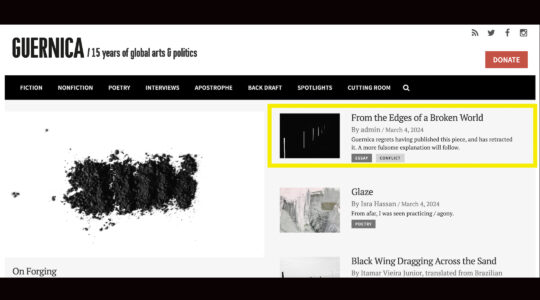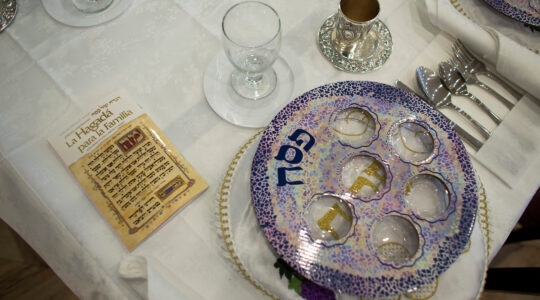In his latest piece of “national security” reportage The New Yorker’s Sy Hersh uses insinuations and several leaps of logic to raise questions about the wisdom of the Bush administration’s apparent funding of covert activities designed to destabilize Iran’s religious leadership.
The headline and Hersh’s juxtapositions suggest that Hersh believes these activities are problematic and a sign that the Bush administration is “preparing the battlefield” for a U.S. attack against Iran.
But the activities also could be interpreted as just the opposite: The White House may be taking this action as an alternative to launching a full-out assault against the Islamic Republic and its suspected nuclear weapons program, and it may well prove more successful than an attack, sanctions or doing nothing.
Hersh makes several leaps of logic in his piece.
The first focuses on whether or not the White House’s initiative – $400 million worth of activities authorized by an executive order called a Presidential Finding – is for military activity to overthrow the regime in Tehran, and whether killing is an intrinsic or merely incidental part of the operations.
The anonymous administration sources cited in the story (they’re almost all anonymous in Hersh’s reporting) say the operations are not about killing:
As far as the C.I.A. was concerned, [a] former senior intelligence official said, “the over-all authorization includes killing, but it’s not as though that’s what they’re setting out to do. It’s about gathering information, enlisting support.”
The defensive-lethal language led some Democrats, according to congressional sources familiar with their views, to call in the director of the C.I.A., Air Force General Michael V. Hayden, for a special briefing. Hayden reassured the legislators that the language did nothing more than provide authority for Special Forces operatives on the ground in Iran to shoot their way out if they faced capture or harm.
The legislators were far from convinced. One congressman subsequently wrote a personal letter to President Bush insisting that “no lethal action, period” had been authorized within Iran’s borders. As of June, he had received no answer.
Members of Congress have expressed skepticism in the past about the information provided by the White House.
So has Hersh.
But isn’t this what the doves have been pushing for all along? They’d prefer the White House provide support for regime change in Iran from the inside, rather than seeing the U.S. adapt the hawks’ call to attack Iran head-on.
The survival of the current regime in Iran isn’t a partisan issue. Neither the Democrats nor the Republicans want to see the perpetuation of a government that supports and sponsors terrorist groups, threatens U.N. member states (Israel and some Persian Gulf countries, including Bahrain), has nuclear ambitions, and on a daily basis persecutes and represses its own citizens.
So what’s the problem with the White House spending $400 million a year to try and change that in a less destructive and costly way than a frontal attack?
Here’s where Hersh makes a couple of leaps of logic. He assumes the executive order is about mounting lethal operations against Iranian security forces, and he assumes U.S. forces are undertaking just that. Since he hasn’t been able to turn up any concrete evidence to support that claim, he writes his piece in such a way as to insinuate that U.S. agents in Iran are involved in deadly attacks against Iranian authorities. Watch carefully for how he does this:
- In recent months, according to the Iranian media, there has been a surge in violence in Iran; it is impossible at this early stage, however, to credit [Joint Special Operations Command] or C.I.A. activities, or to assess their impact on the Iranian leadership.
(emphasis added)
It could not be learned whether there has been American involvement in any specific incident in Iran, but, according to Gardiner, the Iranians have begun publicly blaming the U.S., Great Britain, and, more recently, the C.I.A. for some incidents.
(Well, if Iran publicly blames the U.S., then it must be true…)
Hersh is forced to acknowledge that U.S. forces may not be attacking Iranian authorities directly, but supporting anti-government insurgent groups much the way U.S. forces aided surrogates in the war against the Taliban in Afghanistan.
Many of the activities may be being carried out by dissidents in Iran, and not by Americans in the field.
(“May be being carried out?” Where’s Hersh’s evidence to the contrary?)
Then Hersh mounts the argument against the strategy of supporting anti-Iranian military activity, using academics and other quotables as proxies (and omitting contrasting voices):
Relying heavily on a retired U.S. Air Force colonel, Sam Gardiner, “who has taught strategy at the National War College and now conducts war games centered on Iran for the federal government, think tanks, and universities,” Hersh promotes the idea that “the violence, rather than weakening Iran’s religious government, may generate support for it.”
Hersh goes on:
A strategy of using ethnic minorities to undermine Iran is flawed, according to Vali Nasr, who teaches international politics at Tufts University and is also a senior fellow at the Council on Foreign Relations.
The White House’s reliance on questionable operatives, and on plans involving possible lethal action inside Iran, has created anger as well as anxiety within the Special Operations and intelligence communities.
Hersh’s source? An anonymous “Pentagon consultant who is involved in the war on terror,” who says:
“We’ve had wonderful results in the Horn of Africa with the use of surrogates and false flagsbasic counterintelligence and counter-insurgency tactics. And we’re beginning to tie them in knots in Afghanistan. But the White House is going to kill the program if they use it to go after Iran. It’s one thing to engage in selective strikes and assassinations in Waziristan and another in Iran. The White House believes that one size fits all, but the legal issues surrounding extrajudicial killings in Waziristan are less of a problem because Al Qaeda and the Taliban cross the border into Afghanistan and back again, often with U.S. and NATO forces in hot pursuit. The situation is not nearly as clear in the Iranian case. All the considerationsjudicial, strategic, and politicalare different in Iran.”
Finally, Hersh uses U.S. opinion polls to argue against the anti-government activities he believes are taking place in Iran. He cites a Gallup poll from November 2007 that showed that only 18 percent of those polled favored U.S. military action against Iran, as opposed to 73 percent who favored economic action and diplomacy.
It’s a bit disingenuous to cite this poll, however, when the question – “What do you think the United States should do to get Iran to shut down its nuclear program: Take military action against Iran or rely mainly on economic and diplomatic efforts?” – likely prompted respondents to assume Gallup was asking about a major U.S. strike against Iran, not the type of covert operations Hersh describes in his article.
Ominously, Hersh warns that U.S. public opinion could shift in favor of a war against Iran, if the administration manipulates them the right way. Concluding, he notes that both John McCain and Barack Obama have said they’d keep the threat of military action against Iran on the table.
––-
My problem with this piece isn’t the implicit criticism of the strategy of using covert operatives to weaken the Iranian regime’s stranglehold on its people, though that strategy seems prudent and timely, especially given the alternatives (full-out war or doing nothing). Nor is it impossible that the administration is doing the things Hersh attributes to it.
My problem is that Hersh’s piece isn’t supported by the facts he presents, the reporting is one-sided, the piece is selective in its reliance on questionable anonymous sources, and it’s an opinion essay parading as journalism. Hersh’s story leaves the reader with a sense of great alarm about a strategy – whose manifestation is unclear, and which may or may not be in use – to challenge Iranian power.
If this really were what was going to bring the U.S. to war against Iran (the conclusion that Hersh wants you to be afraid of), why is the administration only spending a lousy 400 million bucks on it?
What do you think? Read the piece and let me know.





